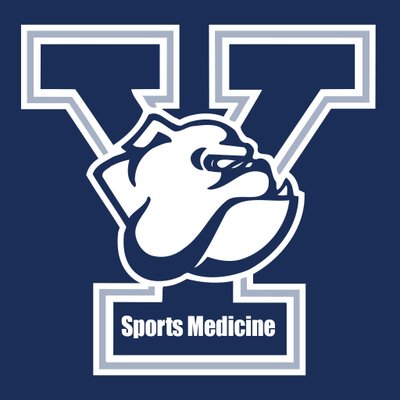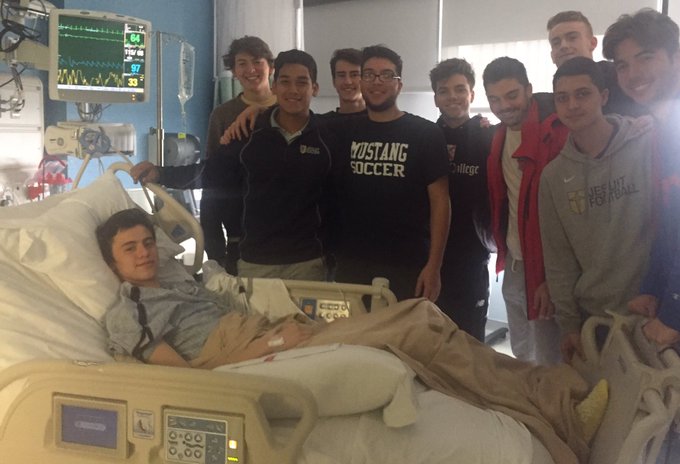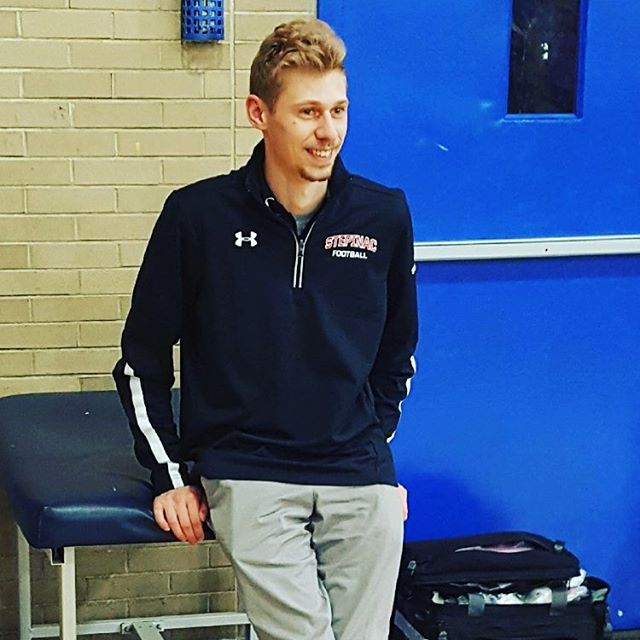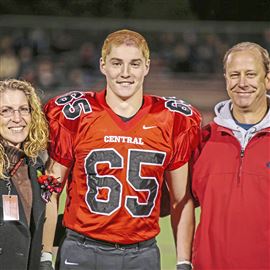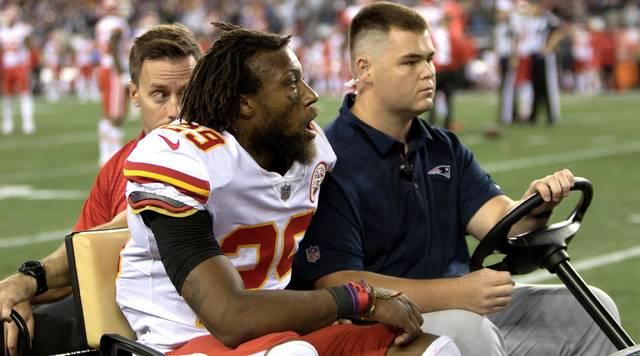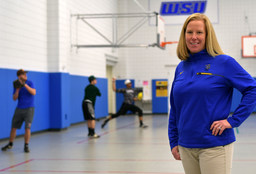
Article reposted from telegram.com
Author: Jennifer Toland
About a month ago, Holy Cross basketball player Marcellis Perkins underwent arthroscopic surgery to clean up his troublesome right knee, and since then he has been a regular visitor to HC’s sports medicine department.
The newly-designed area, which opened in June and is located behind the Hart Center gym, includes a hydrotherapy room, separate sections for taping, treatments and rehabilitation, and it is where Holy Cross’ nine certified athletic trainers, led by head athletic trainer and director of sports medicine Anthony Cerundolo, work tirelessly and passionately with the college’s 27 teams and 750 student-athletes to, first and foremost, try to prevent injuries, but when they do happen, evaluate, triage, manage, treat and rehab the injuries, while also educating student-athletes to help them lead healthier, injury-free lives.
Perkins, a junior, has been spending about 90 minutes a day in the sports medicine department with Wally Tisdale, the men’s basketball team’s athletic trainer, working on flexion, strength and stretching.
“Wally is guiding me through it,” said Perkins, who won’t play this season. “It makes me feel better that our athletic trainers genuinely care. Their main concern is that I’m healthy, that I can get around. Whether I play basketball or not, that doesn’t affect the way they treat us and how they work with us and how much effort they put in to making sure that we’re healthy.”
The role of an athletic trainer, and the importance of that role, may be unknown or unclear to some outside sports.
“I think a lot of people think we’re just the people who squirt water in players’ mouths,” Assumption head athletic trainer Gwen Chiaranda said.
“People hear ‘athletic trainer’ and they don’t really understand the scope or the depth of the position,” said Grafton High athletics director Jim Scanlon, who is a certified athletic trainer. “In my own personal practice I have found there is a general lack of awareness of what an athletic trainer does and how much they are qualified to do.”
“We’re not here just to hand out ice bags and Band-Aids,” Cerundolo added. “We’re here to make sure we’re providing the best possible care we can give student-athletes.”
Indeed, athletic trainers are valued, respected, vital and essential members of sports programs on the college and high school levels.
“Very often,” Chiaranda said, “the first diagnosis of injury comes through us.”
Among Worcester colleges, Holy Cross, Assumption, Worcester State, WPI, Clark and Becker all have partnerships with the UMass Memorial Sports Medicine Group. Holy Cross is also contracted with St. Vincent Hospital. Some area high schools and Worcester Academy also have relationships with UMass Memorial.
Athletic trainers are liaisons between physicians and athletes, and physicians and coaches.
“When a kid gets hurt,” Cerundolo said, “we see everything from the acute stages to X-rays and MRIs, surgery, then rehab. Getting them back to playing in a safe manner, seeing them back playing at a high level, and smiling, that’s the most gratifying part of our job.”
Teamwork, trust and communication among athletic trainers, team physicians, student-athletes, their parents, coaches and teachers, as well as school health offices and administrators, are central to that process.
“As a sports medicine team, a sports medicine family, it’s the role of athletic trainers and team physicians to make the physical and psychosocial welfare of our athletes and our students our highest priority,” said Dr. Brian Busconi, chief of sports medicine at UMass Memorial Medical Center, and the team physician for several area programs. “We are ultimately the people who protect these athletes and make sure they’re getting the best care possible.”

Hildebrand
Pre-game: Athletes have different needs
For a 1 p.m. home football game, Chiaranda, who oversees Assumption’s football, women’s swimming and lacrosse teams, as well as the track and field throwers, arrives to work at about 9 a.m.
She sets up the hot tub, taping and treatment areas, while her work-study students set up both sidelines with six 10-gallon water jugs, ice, taping tables and emergency medical equipment, including splints, the automated external defibrillator (AED), and crutches. They also set up the visiting locker room with water, ice and taping tables.
After the team breakfast, players will start filing in to the training room for soft tissue treatments, massage, stretching and taping.
“From 11:30 to 12:30, I literally stand in front of the taping table and tape whatever I need to tape,” Chiaranda said.
About two hours before a recent Holy Cross women’s basketball game, players streamed into the sports medicine department to see associate head athletic trainer Alicia Caswell, who oversees the women’s basketball team. Caswell helped one player stretch her back, another loosened up on the stationary bike, another had an ultrasound treatment on her ankle.
Worcester State’s new athletic training area is also a pre-game hub.
“Any given day, kids are all over this room,” said Worcester State head athletic trainer Jessica Meany, pointing to the open space, which athletes use for stretching, and to the tables, where they may get a pre-game hot pack treatment on their leg or their ankle taped.
“Once the game starts, hopefully, we get to watch and not see any injuries,” Worcester Academy head athletic trainer Jamie Mili said. “That’s a good feeling for us, but we’re prepared for whatever happens.”

Meany
Game day: Ready to spring into action
Cerundolo and two or three members of his staff, as well as several team physicians, are on the sideline during a Holy Cross football game.
The NCAA requires that an ambulance is on site for football games. HC has an ambulance and paramedics at all athletic events.
Every August at Assumption, Chiaranda and her staff train with the ambulance company.
“They bring the ambulance (to the football field) and we go over spine boarding, we practice putting a kid on a spine board, and all the emergency situations, so in case it does happen, we’ve done it before,” she said.
In addition to an athletic trainer, a physician is required to be present for college football and ice hockey games.
In the first half of a HC football game two seasons ago, quarterback Peter Pujals was tackled after rushing for no gain on a third-down call. After the play, Pujals knelt on all fours and slapped the ground.
Cerundolo ran onto the field to assess the situation.
“We thought at first maybe he caught his ankle and maybe it was an ankle sprain,” Cerundolo said.
Pujals was slow to get up, but hobbled off the field while accompanied by Cerundolo and other members of the athletic training staff, including a team physician. Once Pujals was on the sideline, the evaluation continued.
“On the sideline we were palpating and probing him to see where the injury was,” Cerundolo said.
Pujals spent the rest of the first half on the sideline and was re-evaluated in the locker room at halftime. Pujals had swelling and pain. Cerundolo informed former coach Tom Gilmore that Pujals would not be able to go back in the game. After the game, he went for an X-ray at St. Vincent Hospital and a couple days later an MRI, which revealed a fracture of his lower left fibula.
Pujals missed the rest of the year, but the fracture was non-displaced so he didn’t need surgery. When he was ready, he began rehabbing with Cerundolo and returned to play last season.
Meany will sit near the home bench during a WSU basketball game. If a player goes down in a game, the first order of business, Meany said, “is to try to calm the athlete. Make sure it’s not a serious injury. If it’s a knee injury, for example, we’ll make sure it looks structurally good and there is no major deformity. If the athlete is in severe pain, we’ll immobilize it with a splint, your hands, an Ace bandage, to get them back to the bench so you can evaluate it further. You make sure that person is safe to move. You determine if you need to transport or call 911 or call the orthopedist.”
During an ice hockey game a few years ago, Meany said a Worcester State player took a hit, lost his helmet as he went down and hit the back of his head on the ice. She went onto the ice, stabilized him and called 911. He was taken to UMass by ambulance, ended up being fine and returned to play that season.

Cerundolo
Post-game: Practice coverage, injury reports
Sundays in the fall are a busy time in college athletic training offices for players’ postgame medical check-in for treatment and the first injury report of the week is compiled.
At Holy Cross and Assumption, athletic trainers communicate injury reports with coaches of all teams on a daily basis.
“Daily communication on injuries with coaches is important,” Chiaranda said. “It’s also important for the protection of the athlete.”
An HC injury report includes the athlete’s name, the affected body part, the type of injury (sprain or strain for example), his/her limitations in the weight room, his/her status for practice or the next game, which is determined through collaborative discussions between the athletic trainer and physician, and any other pertinent notes.
Chiaranda documents injuries in SportsWare, which is a medical records software.
Team physicians hold weekly clinics for athletes at local colleges. Dr. Busconi and Dr. Jay Broadhurst cover Holy Cross, Dr. Busconi Worcester State as well, and Dr. Lee Mancini Assumption, for example.
“Our accessibility with UMass phenomenal,” Meany said. “We had a basketball player get injured Saturday. Dr. Busconi saw her Monday. She had an MRI Wednesday. Within four days we knew the plan. I told Dr. Busconi the other day we could use that as a recruiting tool. We are so fortunate to have that access.”
In conjunction with UMass Amherst, Holy Cross also has an excellent sports medicine fellowship program which provides extra coverage for its sports teams.
Holy Cross’ nine athletic trainers cover practices and competitions for all of the college’s contact sports teams.
According to the National Athletic Trainers’ Association (NATA) recommendations and guidelines for appropriate medical coverage of intercollegiate athletics, sports with increased risk (based on injury rate index and catastrophic index) should have a certified athletic trainer physically present for all practices. According to NATA, those sports include men’s basketball, football, men’s and women’s gymnastics, men’s and women’s ice hockey, skiing and wrestling.
The NATA recommendations and guidelines state that “while the task force encourages the physical presence of certified athletic trainers at all home competitions, competition coverage of sports with lower unit values (e.g., golf, outdoor track) will be left to institutional discretion.”
At Assumption, there are four athletic trainers for 24 teams and 550 athletes, so if there is a practice schedule conflict, priority is given to high-risk sports (football, ice hockey, men’s lacrosse).
“It’s always better if you can see an injury happen,” Chiranda said. “It gives you a little bit of insight of how you’re going to treat it or what the injury could be. Being at practice is helpful with that. Last year, I watched a women’s lacrosse player get hurt. I watched it happen and by looking at it, I knew it was her ACL. When we’re covering practice that’s what we’re doing – watching the athlete – and if they get hurt, gaining insight to what might have happened.”
Meany, her full-time assistant Kevin MacLennan and part-time assistant Jason Anderson alternate covering practices for WSU’s 19 teams.
“We make sure every practice and every home competition for every sport is appropriately staffed,” Meany said.
Athletic activities in which an institution decides a certified athletic trainer need not be in attendance, NATA recommendations state, one individual certified in CPR, first aid and AED usage must be present.
Sometimes, athletic trainers cover the visiting teams if an athletic trainer does not travel with a certain team.
In addition, NCAA member institutions should have on file and update annually an emergency action plan for each athletics venue as well as a catastrophic incident guideline.

Mili
High schools: Making the position a priority
At 2:45 on a recent Wednesday afternoon, there were six student-athletes in the athletic training room at Shrewsbury High.
“This is a slow day,” said Walter Hildebrand, Shrewsbury’s High’s athletic trainer. “At the start of winter sports season, we’ll have about 30 kids here with a line out the door.”
Hildebrand provided one-on-one attention to each athlete, including evaluating a football player’s knee, doing an ultrasound treatment on a girls’ lacrosse player’s ankle, and, after senior cross-country and indoor track star Maura McNamara sat at the taping station with a heating pad under her calf for about 10-15 minutes, massaged her lower leg before McNamara began her workout.
“It helps with recovery,” McNamara said.
Hildebrand is in his seventh year at Shrewsbury High. For the first six, Shrewsbury High contracted with All-Access Physical Therapy, where Hildebrand worked.
“This year they decided to take the position in house and now I work for the high school,” he said. “I think it’s essential. Not all schools have the position. I think it’s a really good advantage for schools to have an athletic trainer because we’re the first ones who deal with an injury. Coaches are busy coaching, and by having us on staff, I think we play an essential role not only keeping our kids healthier, but if someone sustains an injury, getting them back to the field faster.”
According to the MIAA, “schools must have medical coverage at all levels of football, wrestling and rugby, and at varsity boys’ and girls’ ice hockey games per sport rules. The school designated as the home team, or the host site identified with a participating school, is recommended to have an AED on site (and accessible) or with their medical person for all athletic events.”
In a Telegram & Gazette survey of Central Mass. high school athletic directors, 13 of those who responded said they employ a full-time athletic trainer, nine a part-time athletic trainer, eight hire per diem athletic trainers and nine said they do not employ an athletic trainer.
“I think we’re seeing an expansion of the role in high schools,” Grafton High director of athletics Jim Scanlon said. “Obviously, with budgetary restraints districts may not be able to afford that position. My perspective is if you can afford to have an athletic program, you absolutely should make having an athletic trainer a priority.”
Schools that do not employ an athletic trainer may hire an EMT and/or ambulance for single-game coverage, or a per diem athletic trainer.
Scanlon served as Grafton’s head athletic trainer until becoming AD this year. Sarah Mealy has moved into the head athletic trainer position at the school while Scanlon continues in the role part time.
“We provide direct coverage for all practices and home competitions for all sports,” Scanlon said. “We’re mandated to cover football and ice hockey, so those take priority in the event we have multiple competitions going on at the same time.”
Scanlon believes educating athletes about an athletic trainer’s role in injury prevention, care and emergency preparedness is vital.
“During preseason meetings,” Scanlon said, “we introduced Sarah, explained her position, what she’s available for and what kind of care she provides.”
In addition to athletic trainers, all members of the athletic staff are required to be CPR and AED certified, Scanlon said.
Mili, who is in his 27th year at Worcester Academy, had the privilege of beginning his career under the legendary Bill “Doc” Samko at WA. Samko, who passed away in 2014 at age 95, was a pioneer in his field and helped to establish the first state and national standards for athletic trainers.
A photo of Samko hangs prominently in the WA athletic training room.
Mili and his two assistants cover 50 teams (middle school, freshman, junior varsity and varsity levels) at Worcester Academy. That includes all home games and practices.
Mili said the NEPSAC, of which Worcester Academy is a member, also requires teams to travel with an athletic trainer.
WA student-athletes may stop in for an evaluation or treatment during a free period, “but the bulk of what we do is after class,” Mili said.
Mili said other prep schools typically have two or three athletic trainers like WA.

Hildebrand
Concussions: Assessing symptoms, daily monitoring
Athletic trainers monitor concussion symptoms (stumbling, slurred speech, vomiting, dizziness, disorientation) closely.
“If we suspect you have head trauma — you get hit and you present any signs or symptoms — you’re removed from practice or the game immediately,” Cerundolo said.
“That also applies if a kid reports symptoms or if a teammate tells you a kid reported symptoms,” Chiaranda said. “When in doubt, take them out.”
The NCAA states that “any student-athlete with signs/symptoms/behaviors consistent with concussion must be removed from practice or competition, must be evaluated by an athletic trainer or team physician with concussion experience and must be removed from practice/play for that calendar day if concussion is confirmed.”
If an athlete has symptoms and is removed, he/she is evaluated on the sideline.
“We’ll do a SCAT 5 neurological form (standardized sideline concussion screening tool) which I then present to the physician,” Cerundolo said.
If a concussion is confirmed, daily monitoring begins.
“They fill out a symptom checklist every day,” Chiaranda said. “When they are symptom free, we start objective measures.”
Athletes take a pre-participation (before the season) baseline concussion assessment test.
“We have all that in the data bank, so when the athlete says they are symptom free, the first step is to take that test again so we can see their scores,” Chiaranda said.
Once the athlete has returned to baseline, the athletic trainer oversees a progression management plan that includes light aerobic exercise without resistance training, sport-specific exercise and activity without head impact, non-contact practice with progressive resistance training, unrestricted training and, after consultation with a physician, return to competition.
All concussions are different.
“A lot recover in 5-7 days,” Cerundolo said. “Others last for weeks. If it continues, we follow up with neurology.”
Returning to the classroom is also part of the process.
“It’s ‘return to learn’ first,” Meany said. “We follow the NCAA protocol and our coaching staff is very supportive. We all have a common goal and that is the well-being of the student and athlete.”
The NCAA concussion management plan states that medical personnel with training in the diagnosis, treatment and initial management of acute concussion must be present (on site at the campus or arena of the competition) at all NCAA varsity competitions in the following contact/collision sports: basketball, equestrian, field hockey, football, ice hockey, lacrosse, pole vault, rugby, skiing, soccer and wrestling.
Medical personnel with training the diagnosis, treatment and initial management of acute concussion must be available (able to be contacted by immediate communication means) at all NCAA varsity practices for the same sports.
The MIAA follows a similar concussion protocol.
“Any student,” Rule 56 states, “who exhibits signs, symptoms or behaviors consistent with a concussion shall be immediately removed from the practice or competition and must not return to practice or competition that day, and further shall not return to play until cleared (in writing to the athletic director) by an appropriate health-care professional.”
The state of Massachusetts requires that parents be notified if their son or daughter is removed from practice or competition. If a concussion is diagnosed, a gradual return-to-classes, return-to-sports plan begins.
“We have a seven-day return-to-play process,” Hildebrand said. “We offer ImPACT (immediate post-concussion assessment and cognitive testing) testing and get them in to see the team doctor. Once they are symptom-free for no less than 48 hours, then we start our graduated process, which entails light exercise. If they are symptom-free, then we ramp it up to some interval work, then more sports specific work. If they are symptom-free, then non-contact practice, then contact practice. If they do well with all that, they are cleared. If their symptoms come back, we go back to square one.”

Chiaranda
Education: Multi-skilled healthcare providers
More than 70 percent of athletic trainers hold at least a master’s degree, according to NATA. Athletic training students are educated to provide comprehensive patient care in prevention, clinical evaluation and diagnosis, immediate and emergency care, treatment and rehabilitation and organization and professional health and well-being.
“The curriculum athletic trainers go through is pretty much pre-med,” said Cerundolo, who earned his bachelor’s in athletic training and physical education from Northeastern and his master’s degree in applied anatomy and physiology from Boston University.
Additionally, to become a certified athletic trainer, a student must pass a comprehensive test administered by the Board of Certification (BOC), and, one certified, meet ongoing continuing education requirements in order to remain certified.
“Athletic trainers are multi-skilled healthcare providers,” Dr. Busconi said.
Holy Cross sports medicine provides immersive internship opportunities for athletic training students from Springfield College, Lasell, Quinnipiac and Moravian College.
“They are here to help and learn,” Cerundolo said.
Like most who work in sports, athletic trainers often work long and non-traditional hours.
In the fall season, Chiaranda works 12 hours a day, Tuesday-Sunday.
“It slows down a bit in the spring,” she said, “but the schedule is never the same.”
During the day and before practices begin in late afternoon, athletes make appointments with Chiaranda and her staff for soft tissue treatments, massage and rehab, and the athletic training staff also spends time at the computer doing administrative tasks like updating medical records and submitting insurance claims.
Meany said her day-to-day operations are basically the same as when she started in the profession 18 years ago.
“I still tape an ankle the same way as I did then,” she said, “but I see now that athletes come in to college more exposed to athletic trainers and what we do. Most have an athletic trainer in high school and they know what we do on a daily basis, and, with that said, they’re seeking us out appropriately.”
Dr. Busconi began his career in sports medicine working with well-known orthopedist Dr. Arthur Pappas and has been a team physician for schools like Holy Cross and Worcester Academy for 25 years.
His relationships with schools’ athletic trainers are strong. They communicate on a daily basis. It is evident he has a great deal of respect and admiration for those in the profession.
“We have to recognize the prime effort and the absolute endurance that these healthcare professionals have in terms of taking care of the athletes,” Dr. Busconi said. “It’s remarkable, their dedication to the athletes and to the schools. They have fantastic interpersonal skills and unbelievable empathy. They truly understand how to nurture somebody through an injury. They’re decisive and confident. They have to be able to make good and confident decisions in the face of anxious situations. I am fortunate to be able to work with these healthcare professionals.”

Locke
Relationships: The mental aspect of injuries
Holy Cross junior Maggie Locke’s athletic journey has been a difficult and sometimes painful one.
A junior forward on the women’s basketball team, knee injuries have limited her to 30 games in three seasons. She has not played this year.
At the end of her freshman season, she underwent microfracture surgery, performed by Dr. Busconi, on her right knee. After a months-long recovery, she tried to play last year, but made into just 10 games.
“The surgery was successful,” Locke said, “but it wasn’t enough.”
Dr. Busconi referred her to a specialist in Hartford and he performed a procedure that involved moving part of Locke’s tibia over in order to align her knee cap properly. She had two screws inserted.
Locke is now in the phase of rehabbing and strengthening with Holy Cross associate head athletic trainer Alicia Caswell, who oversees the women’s basketball team.
Over the last three years, Locke has spent a lot of time in HC’s athletic training room working with Caswell. Currently, Locke is rehabbing six times a week. During practice, she will alternate cardio, circuits and ab exercises.
“When I’m done, I’ll watch practice and cheer,” Locke said, “but Alicia works me hard on the sidelines.”
Leading up to her surgery last summer, Locke could not run or do any type of high impact exercise. She used the anti-gravity treadmill in HC’s athletic training area.
“I was able to keep up my cardio all summer without pounding,” she said. “It’s like you’re lighter and you’re lifted up as you drop the percentage of body weight. You can run much faster and longer because your legs don’t get fatigued. There is less impact.”
Locke has formed a very strong bond with Caswell.
“I got really close to her,” Locke said. “I would look to her whenever anything would go wrong in practice, not just if my knee hurt. Even if I wasn’t playing well, I would look to her and she would help me talk it out. It’s not always related to my injury. She’s someone to talk to, my confidante.”
Perkins, too, said HC’s athletic trainers have helped more than just physically.
“I’m really glad I have people like Wally and ’Dolo here,” Perkins said. “They’ve also helped me with the mental part. A lot of times you don’t realize there is a mental aspect when you get injured in sports. You can feel better physically, but it’s also a mental setback, too, and they are nurturing me and getting me through that, too.”
“When parents drop their son or daughter off at Mount St. James,” Cerundolo said, “we want to assure them they are in good hands.”
Trust is central to the relationship between a student-athlete and an athletic trainer.
“It’s very important to build relationships,” Chiaranda said. “Athletes value our opinion. They know we’re looking out for their best interest. The coaches trust us as well, the doctors, the parents. We all pride ourselves on that.”
“Dr. Busconi refers to this as a sports medicine family,” Mili said. “We all work together as a team (athletic trainers, players, coaches, parents, physicians). We couldn’t do it without them, they couldn’t do it without us. The communication that has to happen between all of us has to be there to make it work. It’s vital.”
McNamara said Hildebrand is treating her calf injury, but it’s more than that.
“He knows I want to get back out and he’ll make sure I can as soon as possible,” McNamara said. “He knows us really well, our sports, our times, our schoolwork, our families. It’s a great personal connection.”



